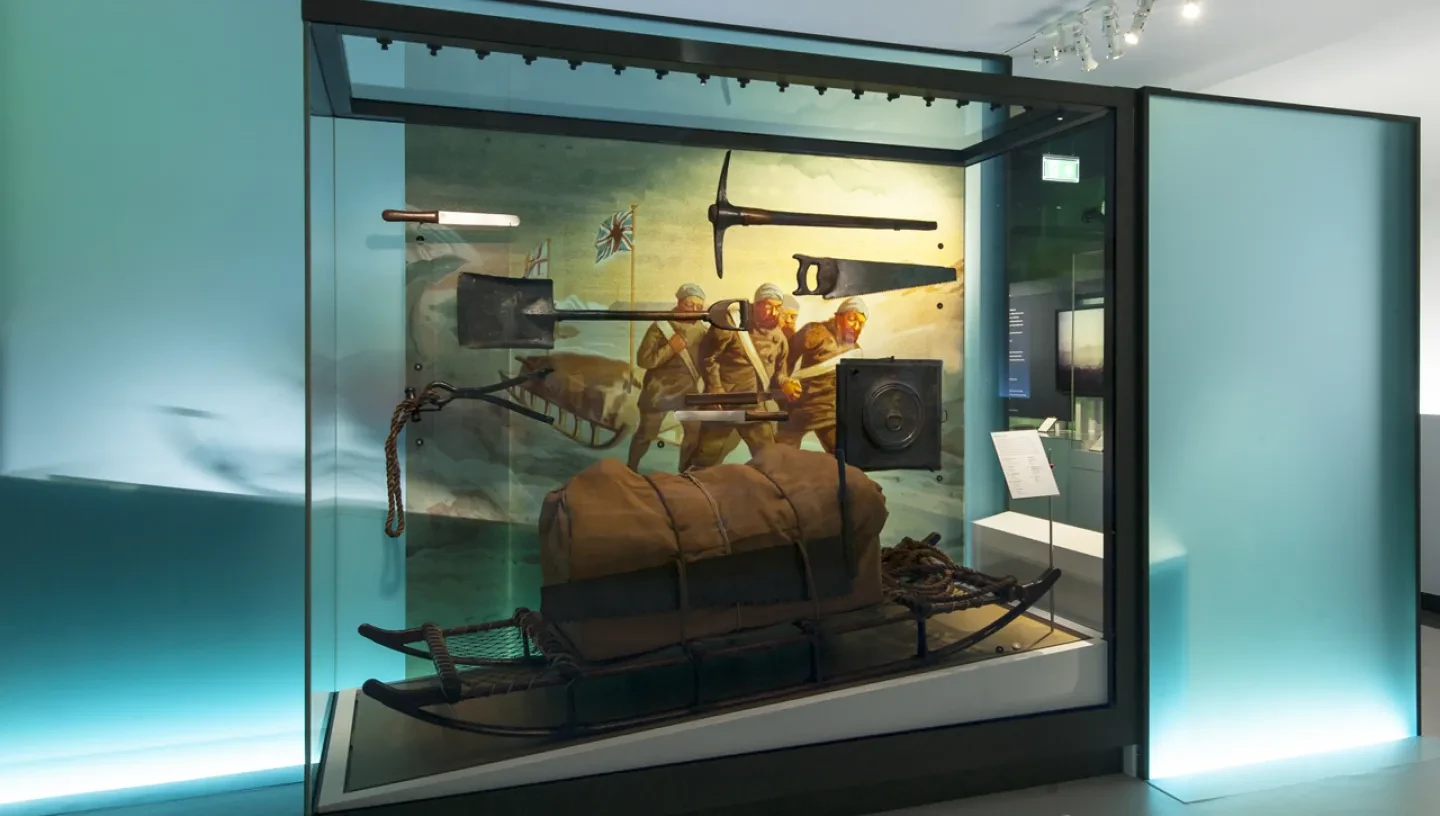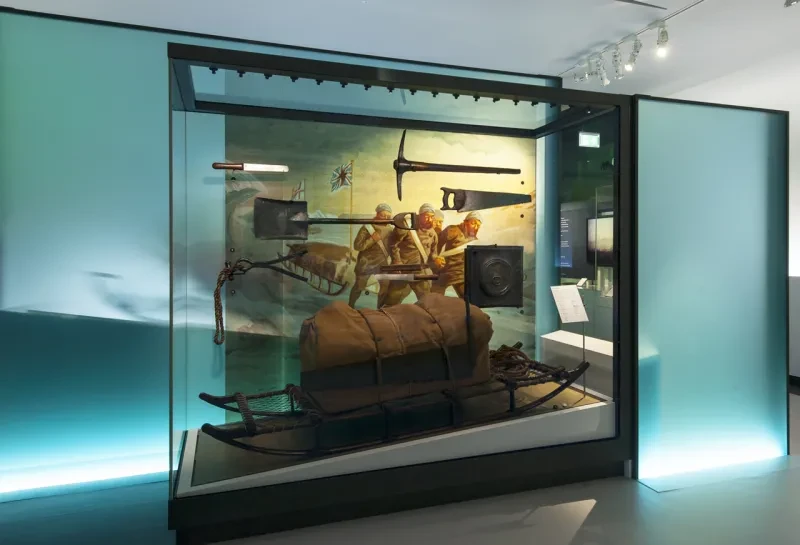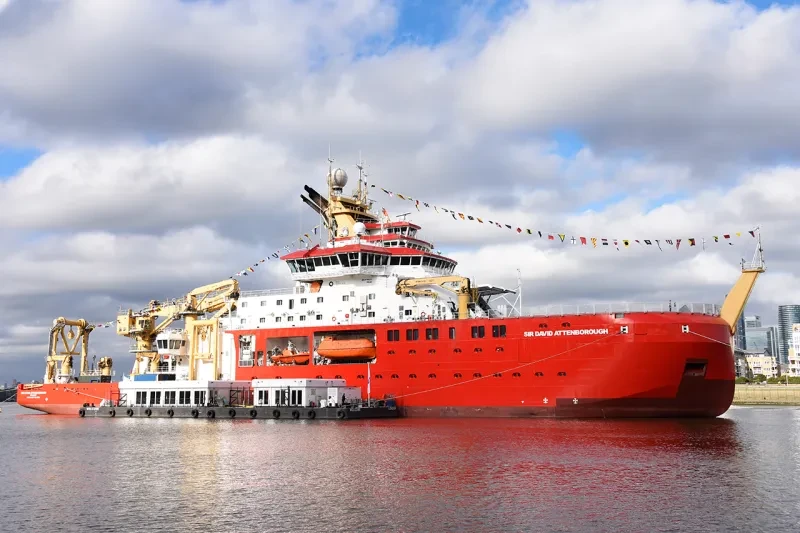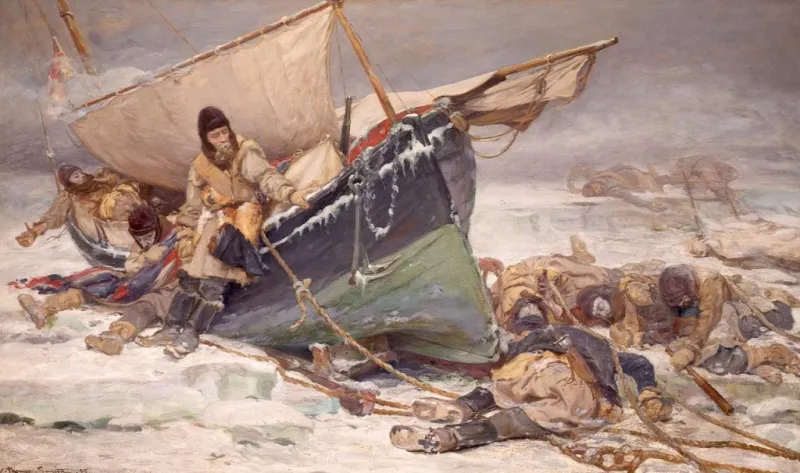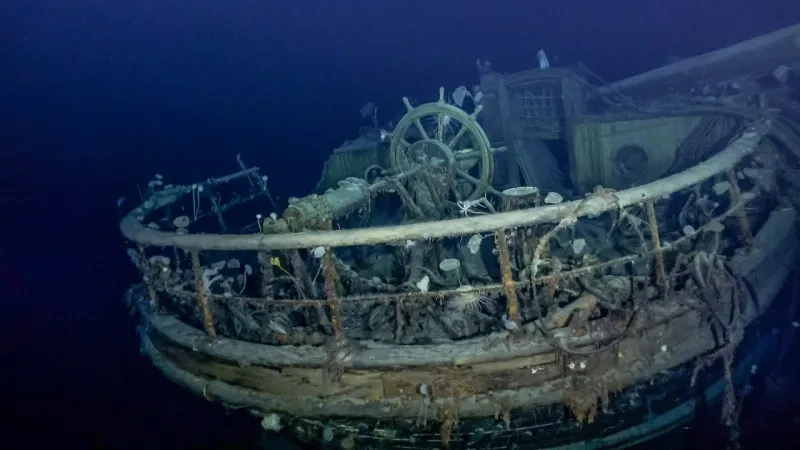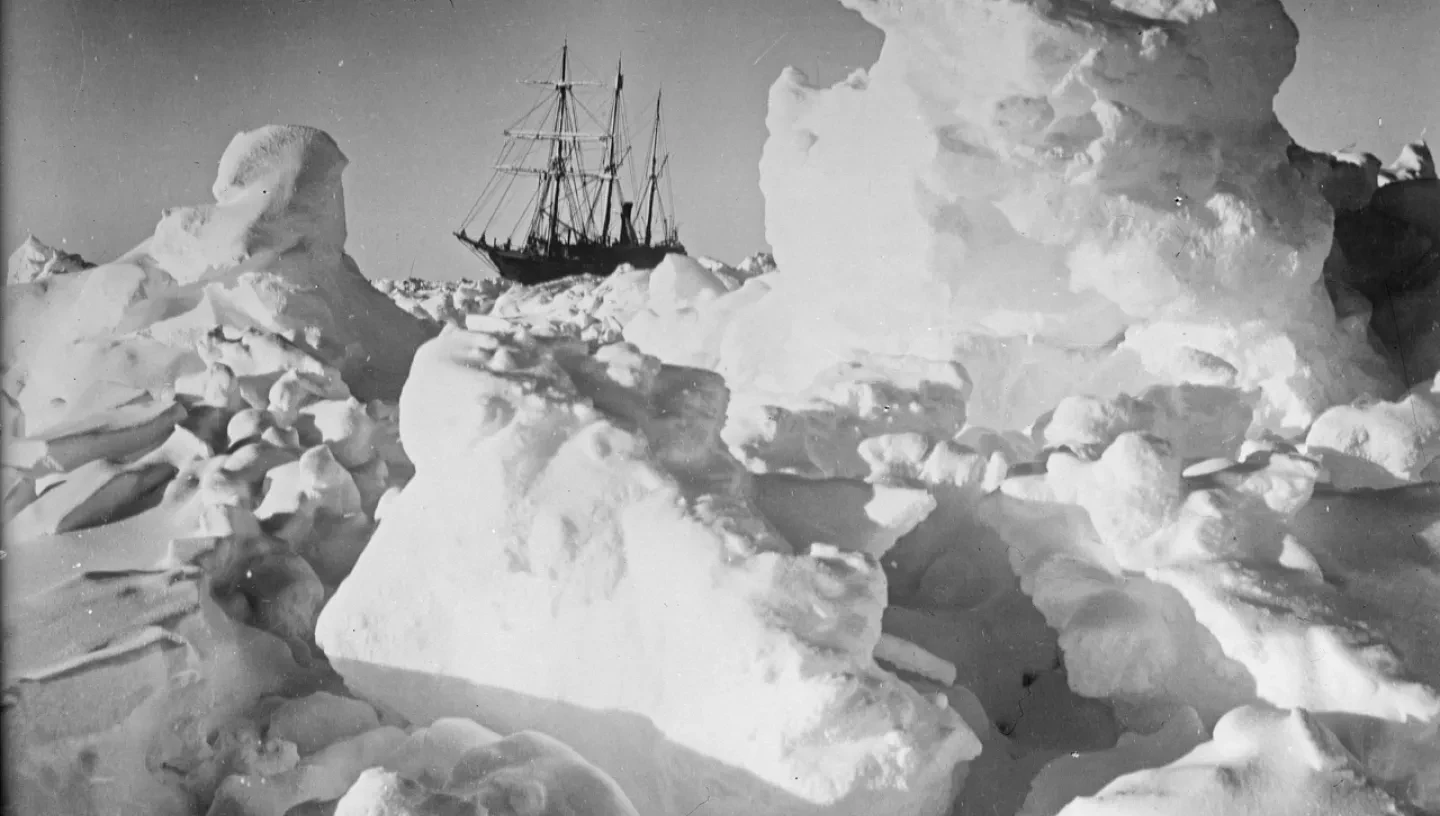
Follow the timeline of discovering Antarctica and the 'race' to the South Pole, from first sighting through to Scott, Amundsen, Shackleton and more.
To find out more about the past, present and future of polar exploration, visit the Polar Worlds and Poles Apart galleries for free at the National Maritime Museum.
7th century: Polynesian narratives of voyaging suggest that Māori people may have been the first to reach Antarctic waters. A 2021 paper published in the Journal of the Royal Society of New Zealand researched oral traditions and other records, which suggest that Māori navigators 'were likely the first humans to set eyes on Antarctic waters and perhaps the continent.'
January 1773: Captain James Cook becomes the first recorded European navigator to cross the Antarctic Circle.
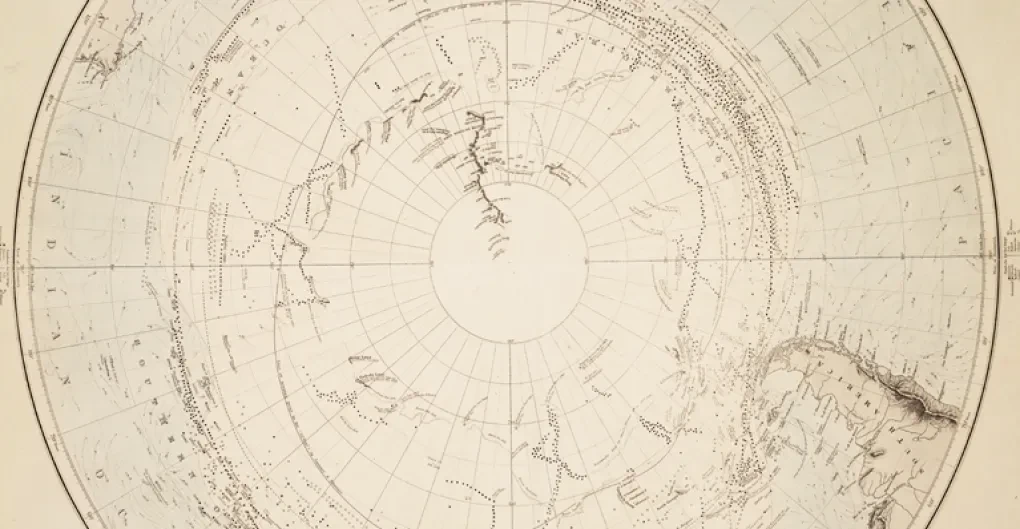
January 1820: Antarctica is 'first sighted' by European explorers. The first person to actually see the Antarctic mainland has been debated: in the last week of January, Thaddeus von Bellingshausen reported seeing 'an ice shore of extreme height' during a Russian expedition to the Antarctic.
Around the same time, Royal Navy officer Edward Bransfield reported seeing 'high mountains, covered with snow' during a British mapping expedition. Captain Cook's expedition 50 years previously never sighted land.
20 February 1823: Captain James Weddell sets a new record for the furthest south ever travelled by an Antarctic explorer. The Weddell Sea is named after him, as is the Weddell seal – the most southerly breeding land mammal in the world.

1831-32 Captain John Biscoe becomes the third person after Cook and Bellingshausen to circumnavigate Antarctica. During his expedition, he sights new areas of the continent including Enderby Land and Graham Land.
1839-41 James Clark Ross commands Erebus and Terror (the ships later to be lost during Franklin’s search for the North-West Passage) to the Antarctic. During the expedition, Ross discovers the Ross Sea and Ross Ice Shelf: this region would later serve as the starting point for both Amundsen and Scott’s expeditions to the South Pole in 1911.
1898-99 The Belgian ship Belgica led by Adrien de Gerlache becomes the first vessel to spend a winter in the Antarctic after becoming trapped in ice for a year. Among the crew on the ship is Norwegian explorer Roald Amundsen, later to become the first person to reach the South Pole.
1899 Norwegian Carsten Borchgrevink leads the first British expedition in what would come to be known as the ‘Heroic Age' of Antarctic exploration. Borchgrevink's expedition is the first to spend a winter on the Antarctic mainland, and the first to use dogs and sledges on the continent.

"Long beards, hair dirt, swollen lips & peeled complexions, & blood-shot eyes made them almost unrecognisable."
1901-1904 Captain Robert Falcon Scott leads his first expedition to the Antarctic in the specially built ship Discovery.
During the National Antarctic Expedition, Scott, Ernest Shackleton and EA Wilson travel to within 410 miles of the South Pole before they are forced to turn back on 30 December 1902. When they return to their base at the Discovery, the three men are described as ‘almost unrecognisable’, with ‘long beards, hair dirty, swollen lips & peeled complexions & blood-shot eyes’.
1907-1909 Ernest Shackleton leads the second British Antarctic Expedition on the Nimrod. On 9 January 1909, Shackleton, Frank Wild, Eric Marshall and Jameson Adams come within 97 miles of the South Pole, but the return trip almost costs them their lives. On 3 March, all four men finally arrive back at the Nimrod, after having initially been given up for dead by the men stationed on the ship.
1910 Robert Falcon Scott and Roald Amundsen both depart for Antarctica on their separate expeditions to reach the South Pole. Scott and his crew leave Cardiff on the Terra Nova on 15 June; Amundsen departs Kristiansand on 9 August on the Fram.
Amundsen had originally planned to make a bid for the North Pole, but changed his objective after two American explorers each claimed to have reached the goal. He only revealed his South Pole ambitions to his crew after he had set sail.
Scott discovered that he was in a ‘race’ on 13 October after landing in Melbourne, Australia. Amundsen’s brother Leon had sent Scott a telegram, simply saying: ‘Beg leave to inform you Fram proceeding Antarctica. Amundsen.'

Scott is wearing a canvas over-jacket with the canvas webbing attached to large fur gloves, a knitted balaclava, and over-trousers tied with putties over finnesko fur boots.
The photograph was taken on the day that Scott returned to Cape Evans from Hut Point where they had been laying depots ready for the scientific and South Pole expeditions later in the year.
15 October 1911 Amundsen sets out to reach the South Pole with five men, four sledges and 52 dogs, travelling to pre-prepared depots and killing dogs for food as they go. Seventeen of the original 52 dogs would make it to the Pole, and 12 made it back.
1 November 1911 Scott’s main party sets out. The initial plan included the use of ponies, dogs and tractors to carry supplies, with only the final push to the Pole using manpower alone.
However, setbacks and equipment failure meant that Scott would have to man-haul far further and on fewer provisions than he had originally planned.
15 December 1911 At 3pm Roald Amundsen becomes the first person to reach the South Pole. The five men – Amundsen, Helmer Hanssen, Olav Bjaaland, Sverre Hassel and Oscar Wisting – make careful observations of the site for the next two days, and leave behind messages and spare equipment for Scott’s party. The whole team arrive safely back at base camp on 26 January, having travelled more than 1,600 miles in 99 days.
18 January 1912 Scott and his final team – Captain Oates, Lieutenant Bowers, Petty Officer Evans and Dr Wilson – reach the South Pole. They find Amundsen’s tent and realise they have been beaten. ‘Great God!’ wrote Scott, ‘this is an awful place and terrible enough for us to have laboured to it without the reward of priority. Well, it is something to have got here, and the wind may be our friend tomorrow. Now for the run home and a desperate struggle. I wonder if we can do it.’ The party leave the next day.
17 February 1912 Petty Officer Edgar Evans dies in his tent after collapsing during the trip back.
16-17 March 1912 Scott’s diary records Captain Lawrence Oates’s death. According to Scott, Oates walked out of his tent with the words, ‘I am just going outside and may be some time’. His body was never found.
29 March 1912 The remaining three explorers are around 11 miles from their final depot at One Ton when Scott writes his final diary entry:
Had we lived, I should have had a tale to tell of the hardihood, endurance and courage of my companions which would have stirred the heart of every Englishman. These rough notes and our dead bodies must tell the tale.
We shall stick it out to the end, but we are getting weaker, of course, and the end cannot be far. It seems a pity but I do not think I can write more. For God’s sake look after our people.
The bodies are discovered seven months later.
26 February 1914 Australian explorer Douglas Mawson returns to Australia after a two-year Antarctic expedition. During a sledging journey, Mawson was forced to trek over 100 miles alone following the death of his two companions, Belgrave Ninnis and Xavier Mertz. Mawson finally returned to base on 8 February 1912, only to discover that his ship had left just hours before. Mawson, along with six others, remained in the Antarctic for another 12 months before help returned.
1 August 1914 Ernest Shackleton departs on the Endurance on his Trans-Antarctic Expedition, aiming to become the first to cross Antarctica from sea to sea via the South Pole.

Born in Ireland, Shackleton was educated at Dulwich College, London, before becoming a merchant seaman in sail and steam and then an explorer who three times attempted to reach the South Pole. In 1901 he sailed as a member of Captain Robert Falcon Scott's first expedition to Antarctica, in the 'Discovery', and was one of Scott's party who reached 'furthest south' before being forced to turn back. In 1907 commanding his own expedition in 'Nimrod', he again attempted to reach the South Pole, coming within 179 km of his goal, a new record, for which he was knighted. In 1914, after both Amundsen and Scott had reached the Pole, he sailed in the 'Endurance' to try and cross Antarctica from the Weddell Sea to the Ross Sea, via the Pole. Instead 'Endurance' was trapped before reaching land in the Weddell Sea ice and eventually crushed, marooning Shackleton and his men on the northward drifting pack. From this they finally made a dangerous escape in boats to Elephant Island, followed by Shackleton's epic 800-mile voyage in the 'James Caird', with five companions, to seek help from South Georgia. In 1916 he rescued all his men from Elephant Island and then the survivors of his second party in the Ross Sea.
In 1921, after army service in the later part of the First World War, Shackleton undertook one more Antarctic trip in the 'Quest', an expedition largely supported by a wealthy fellow pupil at Dulwich, John Quiller Rowett. However, on 15 January 1922, on the night of his arrival at Grytviken, South Georgia, Shackleton died suddenly of a heart attack, aged 47. His exertions to finance his expeditions and the immense strain of the journeys themselves wore out his strength. There is also little doubt that he had a longstanding heart condition, which he had consistently refused to have investigated.
This portrait was probably painted from life before Shackleton set off on his final voyage and was purchased from the sale of the artist's studio collection at Bonham's in 1974. The Scott Polar Research Institute at Cambridge has a sketch for it. The National Portrait Gallery has a smaller version (NPG2608, 610 x 508 mm/ 24 x 20 ins) also dated 1921 and showing the sitter dressed the same way, but turned to face the viewer.
19 January 1915 Endurance becomes stuck in the pack ice of the Weddell Sea. Shackleton hopes to spend the winter on board and wait for the ice to free them, but over the course of the next nine months the ship is gradually crushed. The crew finally abandon the ship on 27 October, and all 28 men are left stranded on the frozen sea.
9 April 1916 Unable to remain on the sea ice any longer, the party abandon their ‘Ocean Camp’ in three lifeboats: the James Caird, the Dudley Docker and the Stancomb-Willis. The closest solid land, the uninhabited Elephant Island, is over 100 miles away, but all three boats reach their destination on 17 April.

24 April 1916 Six men including Shackleton leave on the James Caird in search of rescue, planning to sail 800 miles to the whaling stations of South Georgia. The rest of the group remain on Elephant Island, using the upturned boats as shelter.
Shackleton and the rescue party finally reach South Georgia 17 days later, but are forced to land on the uninhabited side of the island. The party treks without sleep across the unmapped island, finally reaching the Norwegian whaling station at Stromness on 20 May. It would take until 30 August before Shackleton could reach the rest of his men left on Elephant Island. All 28 men survived.
1914-17 While Shackleton and his men struggled to survive the loss of Endurance, the second half of the Trans-Antarctic Expedition faced their own challenges. The Ross Sea Party had been tasked with laying supply depots along the Antarctic route from the opposite side of the continent, which Shackleton planned to use during the final part of his expedition. However, their ship broke free and the men left behind were not rescued until January 1917. While the depots were never used, the group managed to cover 1,356 miles across the ice laying supplies. Three men died during the expedition.
5 January 1922 Ernest Shackleton dies of a heart attack during an expedition to the Antarctic on board the Quest.
29 November 1929 Expedition leader Richard Byrd, pilot Bernt Balchen, co-pilot Harold June and radio operator Ashley McKinley become the first people to fly over the South Pole.
20 February 1935 Danish Norwegian explorer Caroline Mikkelsen becomes the first woman to set foot on Antarctica.
14 December 1943 Britain launches the secret wartime mission Operation Tabarin, establishing permanent bases in the Antarctic for the first time. The resulting bases were later given over to scientific research, and became the foundation for the British Antarctic Survey in 1962.
2 March 1958 The Commonwealth Trans-Antarctic Expedition led by Vivian Fuchs becomes the first to successfully cross the continent, travelling 2,158 miles in 99 days. Mount Everest climber Edmund Hillary leads part of the mission, laying supplies for the crossing party as far as the South Pole. In the process he leads just the third group to reach the South Pole, and the first to do so in vehicles.

23 June 1961 The Antarctic Treaty comes into force, an international agreement establishing how the continent should be protected and governed. Twelve countries – Argentina, Australia, Belgium, Chile, France, Japan, New Zealand, Norway, South Africa, the Soviet Union, the UK and the USA – first signed the international treaty in 1959, declaring that Antarctica should be ‘a natural reserve, devoted to peace and science’.
1992-1993 Ranulph Fiennes and Dr Mike Stroud become the first people to cross the Antarctic continent unsupported, without assistance or extra supplies.
